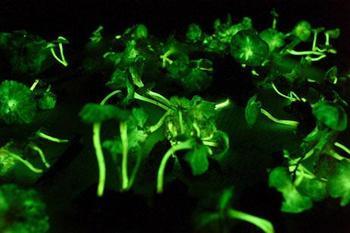 Inspired by Firefly scientists can foster scientific and practical light-emitting plants <br> <br>
Inspired by Firefly scientists can foster scientific and practical light-emitting plants <br> <br> Recently, a commercial development project for "sustainable light plants" has attracted the interest of many corporate sponsors.
It is reported that the special feature of this project is to let the plants continue to shine through bioluminescence technology. The R&D team of the technology introduced that the goal of the research is to use sustainable light-emitting plants for street lighting in the future and even to use light-emitting small bonsai as reading lamps. It sounds cool, let's take a look at how light plants work.
Experimental Vector: Arabidopsis It is reported that this creative experimental team is composed of synthetic biologists and botanists from Stanford University in California. Scientists said that they are currently transplanting the luciferase gene into a plant called Arabidopsis thaliana, which is ubiquitous on fireflies and some luminescent fungi. "Inspired by fireflies, our team members are trained Dr. Stanford, our ready-made method used in the biological laboratory to create truly luminous plants," the research team said on its website.
Researchers have transplanted the luciferase gene into a fungus that can embed its own genes in other plants. After the luminescent fungus was cultivated, the researchers placed the fungus along with the Arabidopsis seeds in a culture medium so that the fungus inserted its own gene into Arabidopsis seeds and continuously observed the genetic structure of the plant. Variety.
At present, researchers have cultivated the seed of Arabidopsis that can emit light, and have already compiled the gene sequence. Scientists will then “print†this gene sequence and eventually transplant it to other plants. "My prediction is that this project will have dimly visible plants in a dark room," said project leader Anthony Evans.
Raised funds: 260,000 US dollars
The enthusiasm of the outside world for the project exceeded the imagination of the experimental team. They released a fundraising plan on the popular creative fundraising platform. The initial goal was to raise only 65,000 U.S. dollars, but now it has attracted nearly 4,700 investors and raised more than 26 Million dollar funding. The experimental team promised that investors who donated more than $150 would send the first cultivated Arabidopsis seeds.
George, a professor of genetics at Harvard Medical School, is one of the patrons of this project. He believes that this kind of biotechnology will bring more inspiration to “continuous lightingâ€. "Biology is very energy-efficient. Plants do not need to consume extra energy. They are easy to handle. They are environmentally friendly. They emit lighter energy than battery packs. Even weakly glowing flowers will be a great sign," Professor George said.
Potential risks: biological variation
The next step for the experimental team is to make the rose glow, which will make this technology more commercially valuable, and apply this technology to other business areas such as planting and flower gardening. According to the report, if the technology is sponsored by the company, it will have great potential for market development. However, the risk of this technology is currently not yet assessable. Plants that may be cultivated will suffer from insufficient light, and scientists fear that plants containing this gene will experience biological variation.
In fact, the issue of “giving animals and plants light†is not new in the scientific community. The key is how to reject this technology to be more practical and easier to commercialize. In 2008, scientists at the University of California created a glowing tobacco plant with luciferase; in 2010, researchers at Cambridge University also allowed bacteria to glow.
About Silicone Cake Molds:
In our kitchen,we usually use metal utensils,but sometimes,they will rust,and will be harmful our health.Is there anything that can take place of our kitchen utensils?
We can use silicone products instead of some metal products,for example we can use Cake Silicone Mold instead of common cake molds, Cake Mold Silicone is lighter than common one,and its material is Food Grade.We can do the own design,which have lots of shape to bake cake.silicone cake mold is not only light,but also easy to carry,wherever you go,you can take it outside or other places.In a word,it's suitable for all people.
Other Type Silicone Cake Decorating Mold can be clicked on Silicone Cake Mould , Silicone Cake Tools ,Cake Decorating Silicone Molds.
Product introduction:
1.Product name:Cake Silicone Mold ,Cake Mold Silicone,Silicone Cake Decorating Mold,Silicone Cake Mould, Silicone Cake Tools,Cake Decorating Silicone Molds
2.Place of origin:Guangdong China
3.Color:any pantone color
4.Logo:Printing,debossed,embossed
5.MOQ:500pcs.
6.Package:1 pcs/opp,customized design is available.
7.Design:Customized/stock
8.Certification:FDA,LFGB,SGS,ROHS,etc.
9.Usage:Use in kitchen baking
10.Silicone Baking Molds photos for reference.

Silicone Cake Molds
Silicone Cake Molds,Cake Silicone Mold,Cake Mold Silicone,Silicone Cake Decorating Mold,Silicone Cake Mould, Silicone Cake Tools,Cake Decorating Silicone Molds
OK Silicone Gift Co., Ltd. , https://www.oemsiliconegift.com